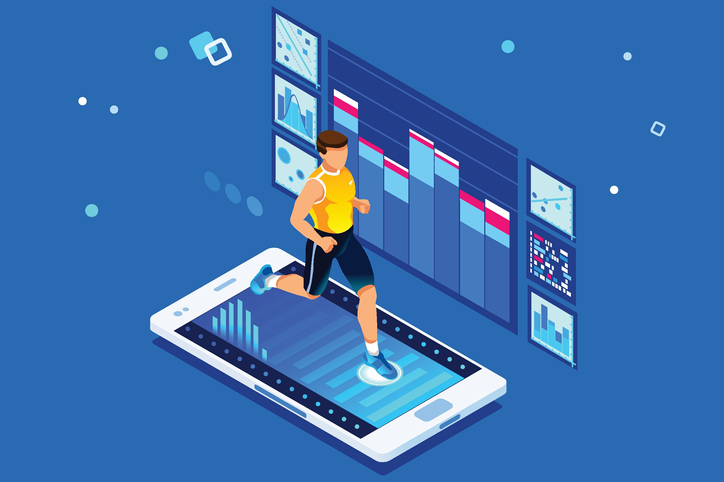Health and Fitness Tracking Goes Mainstream
Self-tracking has moved beyond professional athletes and data geeks.
Since September, Jeanette Cajide has armed herself with an Elite heart-rate variability monitor. And a temperature-controlled mattress pad. And a Levels continuous glucose monitor. And an Oura Ring that also measures heart-rate variability along with resting heart rate, respiratory rate and temperature. “Yeah, I’m a little crazy on the devices,” says Ms. Cajide, director of strategy and operations at consulting firm Clareo.
She’s got good reason. After returning to competitive figure skating four years ago, she won a national championship. Then last September, she broke her leg while landing an Axel jump. Ms. Cajide, who is 44 years old, competes again in eight weeks—against many skaters half her age.
She is trying to override nearly two decades as a “sedentary adult,” working in tech and investment banking. “I’m trying to make up for lost time. It’s me against time,” she says. “The sensors and data allow me to optimize for getting the most mileage out of my body.”
There is no escaping the Quantified Self movement. Measuring biomarkers used to be the preoccupation of extreme athletes and extreme geeks. No more.
“I think the attitude is shifting. The seriousness of the pandemic has made people realize that gosh, isn’t it a good idea to have a sensor,” says Michael Snyder, chairman of the department of genetics at Stanford University’s School of Medicine, whose research, among other studies, indicates data from smart watches—alterations in heart rate, steps and sleep—can be used to detect Covid-19 as early as nine days before symptoms.
Until relatively recently, health-minded people were excited to track their steps and heart rate. Now they can perform their own urine and blood tests, conduct body-fat scans and monitor their emotions. Soon they may be able to monitor their rate of aging to take steps to slow it down. Rings, watches, patches and apps that monitor biomarkers have taken off, buoyed by a pandemic that alerted everyone to “underlying conditions” they might not be aware of.
Fitness and tech companies, already adroit marketers, jumped on the opportunity, intriguing people like Ms. Cajide. They “have created this persona of somebody who’s striving and they’ve done a really good job of it,” says Joe Vennare, co-founder of Fitt Insider, which produces a newsletter and podcast and invests in health, wellness and fitness. Fitness-tech startups raised $2.3 billion in 2020, 30% more than the year before, according to market-intelligence firm CB Insights.
People who track their data are constantly sharing online. One recently tweeted a graph comparing her heart rate: “me walking alone, hauling it: 140 bpm vs. me walking normal with my friend: <110 bpm.” Another boasted that since he began wearing a sleep-tracking device, he has averaged 8.25 hours of uninterrupted sleep a night. Another tweeted eight separate graphs of jagged green and blue lines with an ominous question: “Anyone have heart rate or respiratory rate peaks in the night that is DOUBLE their normal value? I don’t know if this is a medical problem or just the measuring device.”
Self-trackers often fixate on factors that might influence their performance. “It’s interesting to look at these things and learn about yourself. They can help you understand things you couldn’t unearth on your own,” says Chris Bailey, co-founder and chief technology officer of startup NatureQuant and an endurance mountain biker. He’s currently testing the Apollo Neuro, which isn’t a tracker, but is considered another bio-hacking device designed to increase heart-rate variability and optimize performance. Worn on the wrist or ankle, it is designed to reduce stress and recalibrate the nervous system using varying-frequency vibrations that can be programmed to make you more alert in boring meetings, focus better during cognitive or athletic activities and recover more quickly after physical exertion. Mr. Bailey’s early verdict: “It’s a little hard to tell. It helps with focus a little bit, maybe, but it’s certainly not something that 2Xes your performance.”
Individuals react differently to caffeine, pasta, late nights—almost everything. Last year, Whoop added a journal to its sleep-tracking app. In the journal, users can log more than 70 behaviors to see how, over time, they might affect sleep and performance. Activities include taking medication like Advil, drinking wine, reading before bed and having sex. In a podcast introducing the change, Whoop executives said users had frequently requested the sex-tracking feature. For some, sex can raise core body temperature which is counterproductive to sleep, the company explained, so you might want to take that into account the night before a big event.
As for alcohol: Not a good idea, according to Whoop. While many people think alcohol helps them sleep better, it disrupts the repair and recovery that is supposed to happen during slumber. It interferes with physically restorative slow-wave sleep and it “crushes” your mentally restorative REM sleep, Emily Capodilupo, now Whoop’s vice president data science and research, explained in a company podcast. It messes with your heart rate, suppresses recovery and increases the chance of injury.
When Ms. Cajide, the figure skater, heard about sleep tracking, she thought it was silly. “I don’t care what happens at night,’” she recalls thinking. Then she learned the significance of heart-rate variability—not heart rate, which is beats per minute—but the variance in the length of time between heart beats. HRV is a key indicator of how fit, recovered and ready you are to perform, and can be greatly affected by the quality of your sleep. “I went down the rabbit hole,” she says.
Now she wears a continuous glucose monitor—a patch attached to the underside of her arm. Its data displays on her phone, telling her what foods are spiking her glucose and how efficiently she is managing her energy. She programs the temperature of her mattress pad to gradually fall to 62 degrees in the middle of the night, to bring down core body temperature and thus positively influence her heart rate and HRV. So far it has gotten those metrics to their “best points mid-sleep ever,” she says.
She uses her Fitbit as an alarm clock because its vibration doesn’t spike her heart rate and scramble her metrics. Then she checks the data from her Oura Ring and compares it to that of her Elite HRV, “to make sure they’re giving me the same information.”
The information tells her how hard to train—whether she will attempt an Axel, the jump that resulted in her broken leg last fall. Her current program includes two. “On a good recovery day, I’m more comfortable taking risks,” she says. That is crucial because she has only recently recovered but competes again in just eight weeks.
Dr. Snyder at Stanford understands the obsessiveness. He wears four smart watches, two on each wrist, to figure out what variables are the best to measure and “also sometimes one will run out of batteries.” He believes Ms. Cajide’s kind of self-tracking is critical to the future of healthcare, saying, “If people really care about their own health, they are going to have to take charge.”
Reprinted by permission of The Wall Street Journal, Copyright 2021 Dow Jones & Company. Inc. All Rights Reserved Worldwide. Original date of publication: April 12, 2021
 Copyright 2020, Dow Jones & Company, Inc. All Rights Reserved Worldwide. LEARN MORE
Copyright 2020, Dow Jones & Company, Inc. All Rights Reserved Worldwide. LEARN MORE
This stylish family home combines a classic palette and finishes with a flexible floorplan
Just 55 minutes from Sydney, make this your creative getaway located in the majestic Hawkesbury region.
The remote northern island wants more visitors: ‘It’s the rumbling before the herd is coming,’ one hotel manager says
As European hot spots become overcrowded , travellers are digging deeper to find those less-populated but still brag-worthy locations. Greenland, moving up the list, is bracing for its new popularity.
Aria Varasteh has been to 69 countries, including almost all of Europe. He now wants to visit more remote places and avoid spots swarmed by tourists—starting with Greenland.
“I want a taste of something different,” said the 34-year-old founder of a consulting firm serving clients in the Washington, D.C., area.
He originally planned to go to Nuuk, the island’s capital, this fall via out-of-the-way connections, given there wasn’t a nonstop flight from the U.S. But this month United Airlines announced a nonstop, four-hour flight from Newark Liberty International Airport in New Jersey to Nuuk. The route, beginning next summer, is a first for a U.S. airline, according to Greenland tourism officials.
It marks a significant milestone in the territory’s push for more international visitors. Airlines ran flights with a combined 55,000 seats to Greenland from April to August of this year, says Jens Lauridsen, chief executive officer of Greenland Airports. That figure will nearly double next year in the same period, he says, to about 105,000 seats.
The possible coming surge of travellers also presents a challenge for a vast island of 56,000 people as nearby destinations from Iceland to Spain grapple with the consequences of over tourism.
Greenlandic officials say they have watched closely and made deliberate efforts to slowly scale up their plans for visitors. An investment north of $700 million will yield three new airports, the first of which will open next month in Nuuk.
“It’s the rumbling before the herd is coming,” says Mads Mitchell, general manager of Hotel Nordbo, a 67-room property in Nuuk. The owner of his property is considering adding 50 more rooms to meet demand in the coming years.
Mitchell has recently met with travel agents from Brooklyn, N.Y., South Korea and China. He says he welcomes new tourists, but fears tourism will grow too quickly.
“Like in Barcelona, you get tired of tourists, because it’s too much and it pushes out the locals, that is my concern,” he says. “So it’s finding this balance of like showing the love for Greenland and showing the amazing possibilities, but not getting too much too fast.”
Greenland’s buildup
Greenland is an autonomous territory of Denmark more than three times the size of Texas. Tourists travel by boat or small aircraft when venturing to different regions—virtually no roads connect towns or settlements.
Greenland decided to invest in airport infrastructure in 2018 as part of an effort to expand tourism and its role in the economy, which is largely dependent on fishing and subsidies from Denmark. In the coming years, airports in Ilulissat and Qaqortoq, areas known for their scenic fjords, will open.
One narrow-body flight, like what United plans, will generate $200,000 in spending, including hotels, tours and other purchases, Lauridsen says. He calls it a “very significant economic impact.”
In 2023, foreign tourism brought a total of over $270 million to Greenland’s economy, according to Visit Greenland, the tourism and marketing arm owned by the government. Expedition cruises visit the territory, as well as adventure tours.
United will fly twice weekly to Nuuk on its 737 MAX 8, which will seat 166 passengers, starting in June .
“We look for new destinations, we look for hot destinations and destinations, most importantly, we can make money in,” Andrew Nocella , United’s chief commercial officer, said in the company’s earnings call earlier in October.
On the runway
Greenland has looked to nearby Iceland to learn from its experiences with tourism, says Air Greenland Group CEO Jacob Nitter Sørensen. Tiny Iceland still has about seven times the population of its western neighbour.
Nuuk’s new airport will become the new trans-Atlantic hub for Air Greenland, the national carrier. It flies to 14 airports and 46 heliports across the territory.
“Of course, there are discussions about avoiding mass tourism. But right now, I think there is a natural limit in terms of the receiving capacity,” Nitter says.
Air Greenland doesn’t fly nonstop from the U.S. because there isn’t currently enough space to accommodate all travellers in hotels, Nitter says. Air Greenland is building a new hotel in Ilulissat to increase capacity when the airport opens.
Nuuk has just over 550 hotel rooms, according to government documents. A tourism analysis published by Visit Greenland predicts there could be a shortage in rooms beginning in 2027. Most U.S. visitors will stay four to 10 nights, according to traveler sentiment data from Visit Greenland.
As travel picks up, visitors should expect more changes. Officials expect to pass new legislation that would further regulate tourism in time for the 2025 season. Rules on zoning would give local communities the power to limit tourism when needed, says Naaja H. Nathanielsen, minister for business, trade, raw materials, justice and gender equality.
Areas in a so-called red zone would ban tour operators. In northern Greenland, traditional hunting takes place at certain times of year and requires silence, which doesn’t work with cruise ships coming in, Nathanielsen says.
Part of the proposal would require tour operators to be locally based to ensure they pay taxes in Greenland and so that tourists receive local knowledge of the culture. Nathanielsen also plans to introduce a proposal to govern cruise tourism to ensure more travelers stay and eat locally, rather than just walk around for a few hours and grab a cup of coffee, she says.
Public sentiment has remained in favour of tourism as visitor arrivals have increased, Nathanielsen says.
—Roshan Fernandez contributed to this article.
This stylish family home combines a classic palette and finishes with a flexible floorplan
Just 55 minutes from Sydney, make this your creative getaway located in the majestic Hawkesbury region.






















